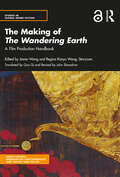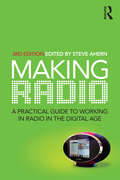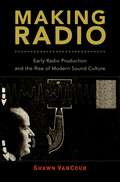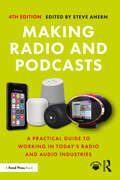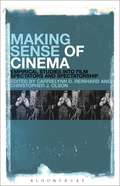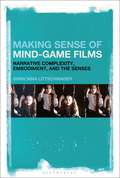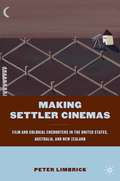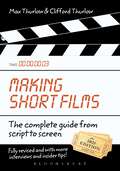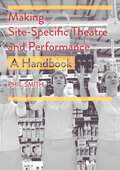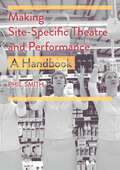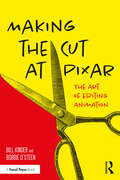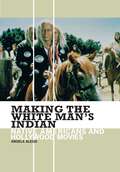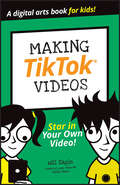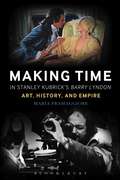- Table View
- List View
The Making of The Wandering Earth: A Film Production Handbook (Studies in Global Genre Fiction)
by Jiaren Wang Regina Kanyu Wang StorycomThis handbook takes us through the making of The Wandering Earth, one of the highest-grossing non-English films of all time. It is a rare, in-depth, behind-the-scenes study of the making of a masterpiece, taking the reader through the entire production process of a landmark Chinese science fiction film. The book brings to life how The Wandering Earth was created, from words to images, by a young and innovative professional team assembled by director Frant Gwo. It discusses specialized details of the filmmaking process and the collaborative work of the crew and the cast involved to present an intuitive feeling of the film’s production. A step-by-step guide on the making of a radical large-scale film, this handbook critically examines its various stages such as its development and production stages – the planning, preparing, recruiting, setting up departments and processes; writing the screenplay; creating a visual style and the production design; and the principal photography; its challenging post-production stages – the editing, visual effects production, color mixing; dubbing, sound editing; publicity, etc. Further, the chapters in volume also explore how Chinese science fiction films disrupt the Western narrative context and provide the larger discourse on Chinese science fiction. Richly illustrated with exclusive first-hand visuals from the making of the film, this handbook, part of the Studies in Global Genre Fiction series, will be an essential read for professionals, scholars, researchers, and students of film and media production, film studies, popular culture, cultural studies, Chinese studies, world literature, and science fiction. It will also be of interest to the general reader interested in filmmaking.
Making Radio: A practical guide to working in radio in the digital age
by Steve Ahern'The distilled wisdom and passion of top practitioners makes this an invaluable guide to making radio in Australia.' - Siobhan McHugh, award-winning radio feature producer and lecturer, University of Wollongong'a very useful hands-on guide to radio production in Australia' - Gail Phillips, Associate Professor of Journalism, Murdoch University'Making Radio has been a core text for all our radio courses since it was written. It covers everything form the basics you need to know when you begin your radio career, to high level skills required for career advancement.' - Kim Becherand, AFTRS Radio DivisionMaking radio programs gets into your blood: it's one of the most stimulating jobs in the world, in a fast-moving industry, at the cutting edge of digital technology.Making Radio is a practical guide for anyone who wants to learn how to make good radio in the era of Radio 2.0. It examines the key roles in radio: announcing, presenting, research, copywriting, producing, marketing and promotions. It also outlines what is involved in creating different types of radio programs: news and current affairs, music, talkback, comedy and WC features, as well as legal and regulatory constraints.With contributions from industry experts, the third edition reflects the impact of digital radio, including multi-platform delivery, listener databases, social media and online marketing. It also examines how radio stations have reinvented their business models to accommodate the rapid changes in communications and listener expectations.
Making Radio: A practical guide to working in radio in the digital age
by Steve Ahern'The distilled wisdom and passion of top practitioners makes this an invaluable guide to making radio in Australia.' - Siobhan McHugh, award-winning radio feature producer and lecturer, University of Wollongong'a very useful hands-on guide to radio production in Australia' - Gail Phillips, Associate Professor of Journalism, Murdoch University'Making Radio has been a core text for all our radio courses since it was written. It covers everything form the basics you need to know when you begin your radio career, to high level skills required for career advancement.' - Kim Becherand, AFTRS Radio DivisionMaking radio programs gets into your blood: it's one of the most stimulating jobs in the world, in a fast-moving industry, at the cutting edge of digital technology.Making Radio is a practical guide for anyone who wants to learn how to make good radio in the era of Radio 2.0. It examines the key roles in radio: announcing, presenting, research, copywriting, producing, marketing and promotions. It also outlines what is involved in creating different types of radio programs: news and current affairs, music, talkback, comedy and WC features, as well as legal and regulatory constraints.With contributions from industry experts, the third edition reflects the impact of digital radio, including multi-platform delivery, listener databases, social media and online marketing. It also examines how radio stations have reinvented their business models to accommodate the rapid changes in communications and listener expectations.
Making Radio: Early Radio Production and the Rise of Modern Sound Culture
by Shawn VanCourThe opening decades of the twentieth century witnessed a profound transformation in the history of modern sound media, with workers in U.S. film, radio, and record industries developing pioneering production methods and performance styles tailored to emerging technologies of electric sound reproduction that would redefine dominant forms and experiences of popular audio entertainment. Focusing on broadcasting's initial expansion during the 1920s, Making Radio explores the forms of creative labor pursued for the medium in the period prior to the better-known network era, assessing their role in shaping radio's identity and identifying affinities with parallel practices pursued for conversion-era film and phonography. Tracing programming forms adopted by early radio writers and programmers, production techniques developed by studio engineers, and performance styles cultivated by on-air talent, it shows how radio workers negotiated a series of broader industrial and cultural pressures to establish best practices for their medium that reshaped popular forms of music, drama, and public oratory and laid the foundation for a new era of electric sound entertainment.
Making Radio: Early Radio Production and the Rise of Modern Sound Culture
by Shawn VanCourThe opening decades of the twentieth century witnessed a profound transformation in the history of modern sound media, with workers in U.S. film, radio, and record industries developing pioneering production methods and performance styles tailored to emerging technologies of electric sound reproduction that would redefine dominant forms and experiences of popular audio entertainment. Focusing on broadcasting's initial expansion during the 1920s, Making Radio explores the forms of creative labor pursued for the medium in the period prior to the better-known network era, assessing their role in shaping radio's identity and identifying affinities with parallel practices pursued for conversion-era film and phonography. Tracing programming forms adopted by early radio writers and programmers, production techniques developed by studio engineers, and performance styles cultivated by on-air talent, it shows how radio workers negotiated a series of broader industrial and cultural pressures to establish best practices for their medium that reshaped popular forms of music, drama, and public oratory and laid the foundation for a new era of electric sound entertainment.
Making Radio and Podcasts: A Practical Guide to Working in Today's Radio and Audio Industries
by Steve AhernMaking Radio and Podcasts is a practical guide for anyone who wants to learn how to make successful programmes in the digital era. It examines the key roles in audio and podcasting: announcing, presenting, research, copywriting, producing, marketing and promotions. It also outlines what is involved in creating different types of programmes: news and current affairs, music, talkback, comedy and features, podcasts, as well as legal and regulatory constraints. With contributions from industry experts, the fully updated fourth edition is global in focus and reflects the impact of podcasts and digital radio, including multi-platform delivery, listener databases, social media and online marketing. It also examines how radio stations have reinvented their business models to accommodate the rapid changes in communications and listener expectations. This is the ideal text for undergraduate and postgraduate students taking courses on radio, audio and podcasting, media production and digital media, with broader appeal to professionals and practitioners in the audio industries.
Making Radio and Podcasts: A Practical Guide to Working in Today's Radio and Audio Industries
by Steve AhernMaking Radio and Podcasts is a practical guide for anyone who wants to learn how to make successful programmes in the digital era. It examines the key roles in audio and podcasting: announcing, presenting, research, copywriting, producing, marketing and promotions. It also outlines what is involved in creating different types of programmes: news and current affairs, music, talkback, comedy and features, podcasts, as well as legal and regulatory constraints. With contributions from industry experts, the fully updated fourth edition is global in focus and reflects the impact of podcasts and digital radio, including multi-platform delivery, listener databases, social media and online marketing. It also examines how radio stations have reinvented their business models to accommodate the rapid changes in communications and listener expectations. This is the ideal text for undergraduate and postgraduate students taking courses on radio, audio and podcasting, media production and digital media, with broader appeal to professionals and practitioners in the audio industries.
Making Sense of Cinema: Empirical Studies into Film Spectators and Spectatorship
by Christopher J. Olson Edited by CarrieLynn D. ReinhardThere are a variety of theoretical and methodological approaches to researching how film spectators make sense of film texts, from the film text itself, the psychological traits and sociocultural group memberships of the viewer, or even the location and surroundings of the viewer. However, we can only understand the agency of film spectators in situations of film spectatorship by studying actual spectators' interactions with specific film texts in specific contexts of engagement.Making Sense of Cinema: Empirical Studies into Film Spectators and Spectatorship uses a number of empirical approaches (ethnography, focus groups, interviews, historical, qualitative experiment and physiological experiment) to consider how the film spectator makes sense of the text itself or the ways in which the text fits into his or her everyday life. With case studies ranging from preoccupations of queer and ageing men in Spanish and French cinema and comparative eye-tracking studies based on the two completely different soundscapes of Monsters Inc. and Saving Private Ryan to cult fanbase of the Lord of the Rings Trilogy and attachment theory to its fictional characters, Making Sense of Cinema aligns this subset of film studies with the larger fields of media reception studies, allowing for dialogue with the broader audience and reception studies field.
Making Sense of Cinema: Empirical Studies into Film Spectators and Spectatorship
by CarrieLynn D. Reinhard Christopher J. OlsonThere are a variety of theoretical and methodological approaches to researching how film spectators make sense of film texts, from the film text itself, the psychological traits and sociocultural group memberships of the viewer, or even the location and surroundings of the viewer. However, we can only understand the agency of film spectators in situations of film spectatorship by studying actual spectators' interactions with specific film texts in specific contexts of engagement.Making Sense of Cinema: Empirical Studies into Film Spectators and Spectatorship uses a number of empirical approaches (ethnography, focus groups, interviews, historical, qualitative experiment and physiological experiment) to consider how the film spectator makes sense of the text itself or the ways in which the text fits into his or her everyday life. With case studies ranging from preoccupations of queer and ageing men in Spanish and French cinema and comparative eye-tracking studies based on the two completely different soundscapes of Monsters Inc. and Saving Private Ryan to cult fanbase of the Lord of the Rings Trilogy and attachment theory to its fictional characters, Making Sense of Cinema aligns this subset of film studies with the larger fields of media reception studies, allowing for dialogue with the broader audience and reception studies field.
Making Sense of Mind-Game Films: Narrative Complexity, Embodiment, and the Senses
by Simin Nina LittschwagerMind-game films and other complex narratives have been a prominent phenomenon of the cinematic landscape during the period 1990-2010, when films like The Sixth Sense, Memento, Fight Club and Source Code became critical and commercial successes, often acquiring a cult status with audiences. With their multiple story lines, unreliable narrators, ambiguous twist endings, and paradoxical worlds, these films challenge traditional ways of narrative comprehension and in many cases require and reward multiple viewings. But how can me make sense of films that don't always make sense the way we are used to? While most scholarship has treated these complex films as narrative puzzles that audiences solve with their cognitive skills, Making Sense of Mind-Game Films offers a fresh perspective by suggesting that they appeal to the body and the senses in equal measures. Mind-game films tell stories about crises between body, mind and world, and about embodied forms of knowing and subjective ways of being-in-the-world. Through compelling in-depth case studies of popular mind-game films, the book explores how these complex narratives take their (embodied) spectators with them into such crises. The puzzling effect generated by these films stems from a conflict between what we think and what we experience, between what we know and what we feel to be true, and between what we see and what we sense.
Making Sense of Mind-Game Films: Narrative Complexity, Embodiment, and the Senses
by Simin Nina LittschwagerMind-game films and other complex narratives have been a prominent phenomenon of the cinematic landscape during the period 1990-2010, when films like The Sixth Sense, Memento, Fight Club and Source Code became critical and commercial successes, often acquiring a cult status with audiences. With their multiple story lines, unreliable narrators, ambiguous twist endings, and paradoxical worlds, these films challenge traditional ways of narrative comprehension and in many cases require and reward multiple viewings. But how can me make sense of films that don't always make sense the way we are used to? While most scholarship has treated these complex films as narrative puzzles that audiences solve with their cognitive skills, Making Sense of Mind-Game Films offers a fresh perspective by suggesting that they appeal to the body and the senses in equal measures. Mind-game films tell stories about crises between body, mind and world, and about embodied forms of knowing and subjective ways of being-in-the-world. Through compelling in-depth case studies of popular mind-game films, the book explores how these complex narratives take their (embodied) spectators with them into such crises. The puzzling effect generated by these films stems from a conflict between what we think and what we experience, between what we know and what we feel to be true, and between what we see and what we sense.
Making Sense of Mind-Game Films: Narrative Complexity, Embodiment, and the Senses
by Simin Nina LittschwagerMind-game films and other complex narratives have been a prominent phenomenon of the cinematic landscape during the period 1990-2010, when films like The Sixth Sense, Memento, Fight Club and Source Code became critical and commercial successes, often acquiring a cult status with audiences. With their multiple story lines, unreliable narrators, ambiguous twist endings, and paradoxical worlds, these films challenge traditional ways of narrative comprehension and in many cases require and reward multiple viewings. But how can me make sense of films that don't always make sense the way we are used to? While most scholarship has treated these complex films as narrative puzzles that audiences solve with their cognitive skills, Making Sense of Mind-Game Films offers a fresh perspective by suggesting that they appeal to the body and the senses in equal measures. Mind-game films tell stories about crises between body, mind and world, and about embodied forms of knowing and subjective ways of being-in-the-world. Through compelling in-depth case studies of popular mind-game films, the book explores how these complex narratives take their (embodied) spectators with them into such crises. The puzzling effect generated by these films stems from a conflict between what we think and what we experience, between what we know and what we feel to be true, and between what we see and what we sense.
Making Sense of Mind-Game Films: Narrative Complexity, Embodiment, and the Senses
by Simin Nina LittschwagerMind-game films and other complex narratives have been a prominent phenomenon of the cinematic landscape during the period 1990-2010, when films like The Sixth Sense, Memento, Fight Club and Source Code became critical and commercial successes, often acquiring a cult status with audiences. With their multiple story lines, unreliable narrators, ambiguous twist endings, and paradoxical worlds, these films challenge traditional ways of narrative comprehension and in many cases require and reward multiple viewings. But how can me make sense of films that don't always make sense the way we are used to? While most scholarship has treated these complex films as narrative puzzles that audiences solve with their cognitive skills, Making Sense of Mind-Game Films offers a fresh perspective by suggesting that they appeal to the body and the senses in equal measures. Mind-game films tell stories about crises between body, mind and world, and about embodied forms of knowing and subjective ways of being-in-the-world. Through compelling in-depth case studies of popular mind-game films, the book explores how these complex narratives take their (embodied) spectators with them into such crises. The puzzling effect generated by these films stems from a conflict between what we think and what we experience, between what we know and what we feel to be true, and between what we see and what we sense.
Making Settler Cinemas: Film and Colonial Encounters in the United States, Australia, and New Zealand
by P. LimbrickThrough a shrewd analysis of the historical experience of imperialism and settler colonialism, Limbrick draws new conclusions about their effect on cinematic production, distribution, reception and filmic discourse.
Making Short Films, Third Edition: The Complete Guide from Script to Screen
by Clifford Thurlow Max ThurlowMaking movies is the most exciting way to earn a living and it is not surprising that media and film studies remain the most popular courses at colleges across the western world. A short film provides an opportunity for elliptical, poetic, condensed story telling. Shorts can take risks rarely seen in features. It is the arena where a strong voice or individual vision is possible; an invitation for experimentation and originality. Making Short Films, 3rd edition is entirely revised and restructured, providing a much more complete and detailed guide to filmmaking, with more information on new technology, illustrations and ideas for best practice.
Making Short Films, Third Edition: The Complete Guide from Script to Screen
by Clifford Thurlow Max ThurlowMaking movies is the most exciting way to earn a living and it is not surprising that media and film studies remain the most popular courses at colleges across the western world. A short film provides an opportunity for elliptical, poetic, condensed story telling. Shorts can take risks rarely seen in features. It is the arena where a strong voice or individual vision is possible; an invitation for experimentation and originality. Making Short Films, 3rd edition is entirely revised and restructured, providing a much more complete and detailed guide to filmmaking, with more information on new technology, illustrations and ideas for best practice.
Making Site-Specific Theatre and Performance: A Handbook
by Phil SmithThis practical, accessible and far-reaching guide to making site-specific theatre and performance emphasises the diversity of approaches to the practice, and explores key principles of space and site. Phil Smith draws on a wide range of interdisciplinary and international performance examples, and uses an innovative variety of exercises, to show students and aspiring performance-makers how to find a site and generate a performance beyond the theatre building.
Making Site-Specific Theatre and Performance: A Handbook
by Phil SmithThis practical, accessible and far-reaching guide to making site-specific theatre and performance emphasises the diversity of approaches to the practice, and explores key principles of space and site. Phil Smith draws on a wide range of interdisciplinary and international performance examples, and uses an innovative variety of exercises, to show students and aspiring performance-makers how to find a site and generate a performance beyond the theatre building.
Making the Cut at Pixar: The Art of Editing Animation
by Bill Kinder Bobbie O'SteenJoin industry insiders Bill Kinder and Bobbie O’Steen as they guide readers on a journey through every stage of production on an animated film, from storyboards to virtual cameras and final animation. With unprecedented access to the Pixar edit suite, this authoritative project highlights the central role film editors play in some of the most critically acclaimed and commercially successful movies of all time. Exclusive interviews with animation editors and other creative leads are supported by footage from deep inside Pixar’s vault. Nearly 90 minutes of video segments include never-before-seen works in progress, deleted scenes, and demonstrations to shed light on how these beloved stories are crafted. The challenges and essential contributions of editors in animation have never been examined in such depth and detail. In addition to exploring method and craft, this book provides important context for the editor in animation history, the evolution of technology, and Pixar’s uniquely collaborative studio culture. A must-read for students of digital filmmaking, filmmakers in all aspects of production, and fans of Pixar movies.
Making the Cut at Pixar: The Art of Editing Animation
by Bill Kinder Bobbie O'SteenJoin industry insiders Bill Kinder and Bobbie O’Steen as they guide readers on a journey through every stage of production on an animated film, from storyboards to virtual cameras and final animation. With unprecedented access to the Pixar edit suite, this authoritative project highlights the central role film editors play in some of the most critically acclaimed and commercially successful movies of all time. Exclusive interviews with animation editors and other creative leads are supported by footage from deep inside Pixar’s vault. Nearly 90 minutes of video segments include never-before-seen works in progress, deleted scenes, and demonstrations to shed light on how these beloved stories are crafted. The challenges and essential contributions of editors in animation have never been examined in such depth and detail. In addition to exploring method and craft, this book provides important context for the editor in animation history, the evolution of technology, and Pixar’s uniquely collaborative studio culture. A must-read for students of digital filmmaking, filmmakers in all aspects of production, and fans of Pixar movies.
Making the White Man's Indian: Native Americans and Hollywood Movies (Non-ser.)
by Angela AleissThe image in Hollywood movies of savage Indians attacking white settlers represents only one side of a very complicated picture. In fact sympathetic portrayals of Native Americans stood alongside those of hostile Indians in the silent films of D. W. Griffith and Cecil B. DeMille, and flourished during the early 1930s with Hollywood's cycle of pro-Indian adventures. Decades later, the stereotype became even more complicated, as films depicted the savagery of whites (The Searchers) in contrast to the more peaceful Indian (Broken Arrow). By 1990 the release of Dances with Wolves appeared to have recycled the romantic and savage portrayals embedded in early cinema. In this new study, author Angela Aleiss traces the history of Native Americans on the silver screen, and breaks new ground by drawing on primary sources such as studio correspondence, script treatments, trade newspapers, industry censorship files, and filmmakers' interviews to reveal how and why Hollywood created its Indian characters. Behind-the-scenes anecdotes of filmmakers and Native Americans, as well as rare archival photographs, supplement the discussion, which often shows a stark contrast between depiction and reality.The book traces chronologically the development of the Native American's screen image while also examining many forgotten or lost Western films. Each chapter will feature black and white stills from the films discussed.
Making TikTok Videos (Dummies Junior)
by Will Eagle Hannah Budke Claire Cohen Andrew Cooper Jordan Elijah Michael Andrew PanturescuCreate videos using the tricks of TikTok stars! Making TikTok Videos reveals the secrets that TikTok celebs and influencers use to make the videos that everyone’s watching. Hilarious clips, the latest dances, instruction videos—whatever you want to do, make sure it shows off the latest TikTok styles. This book shows you how to use whatever you have on hand to record, edit, and upload TikToks. Add music and text, get creative, and start sharing your finished products. With this guide, you’ll get easy instructions on how to make videos that people remember. You also get some tips on how to bring viewers to your account. Use your mobile device to shoot videos with top-notch sound Learn the editing tricks TikTok pros use to create a finished video Set up your TikTok account and set your privacy Keep up with the latest TikTok video stylesWritten especially for the 10-14 age group interested in creating their first TikTok videos, this Dummies Jr. title will help you get plugged into the TikTok universe.
Making TikTok Videos (Dummies Junior)
by Will Eagle Hannah Budke Claire Cohen Andrew Cooper Jordan Elijah Michael Andrew PanturescuCreate videos using the tricks of TikTok stars! Making TikTok Videos reveals the secrets that TikTok celebs and influencers use to make the videos that everyone’s watching. Hilarious clips, the latest dances, instruction videos—whatever you want to do, make sure it shows off the latest TikTok styles. This book shows you how to use whatever you have on hand to record, edit, and upload TikToks. Add music and text, get creative, and start sharing your finished products. With this guide, you’ll get easy instructions on how to make videos that people remember. You also get some tips on how to bring viewers to your account. Use your mobile device to shoot videos with top-notch sound Learn the editing tricks TikTok pros use to create a finished video Set up your TikTok account and set your privacy Keep up with the latest TikTok video stylesWritten especially for the 10-14 age group interested in creating their first TikTok videos, this Dummies Jr. title will help you get plugged into the TikTok universe.
Making Time in Stanley Kubrick's Barry Lyndon: Art, History, and Empire
by Maria PramaggioreConsidered by critics to be Stanley Kubrick's masterpiece, Barry Lyndon has suffered from scholarly and popular neglect. Maria Pramaggiore argues that one key reason that this film remains unappreciated, even by Kubrick aficionados, is that its transnational and intermedial contexts have not been fully explored. Taking a novel approach, she looks at the film from a transnational perspective -- as a foreign production shot in Ireland and an adaptation of a British novel by an American director about an Irish subject. Pramaggiore argues that, in Barry Lyndon, Kubrick develops his richest philosophical mediation on cinema's capacity to mediate the real and foregrounds film's relationship to other technologies of visuality, including painting, photography, and digital media. By combining extensive research into the film's source novel, production and reception with systematic textual analysis and an engagement with several key issues in contemporary academic debate, this work promises not only to make a huge impact in the field of Kubrick studies, but also in 1970s filmmaking, cultural history and transnational film practice.
Making Time in Stanley Kubrick's Barry Lyndon: Art, History, and Empire
by Maria PramaggioreConsidered by critics to be Stanley Kubrick's masterpiece, Barry Lyndon has suffered from scholarly and popular neglect. Maria Pramaggiore argues that one key reason that this film remains unappreciated, even by Kubrick aficionados, is that its transnational and intermedial contexts have not been fully explored. Taking a novel approach, she looks at the film from a transnational perspective -- as a foreign production shot in Ireland and an adaptation of a British novel by an American director about an Irish subject. Pramaggiore argues that, in Barry Lyndon, Kubrick develops his richest philosophical mediation on cinema's capacity to mediate the real and foregrounds film's relationship to other technologies of visuality, including painting, photography, and digital media. By combining extensive research into the film's source novel, production and reception with systematic textual analysis and an engagement with several key issues in contemporary academic debate, this work promises not only to make a huge impact in the field of Kubrick studies, but also in 1970s filmmaking, cultural history and transnational film practice.
